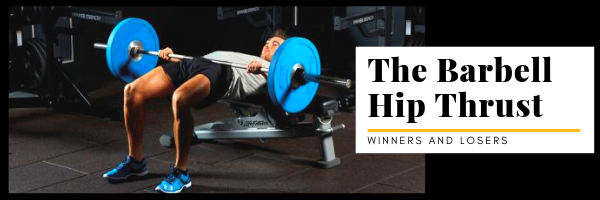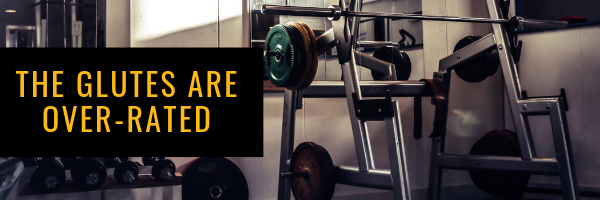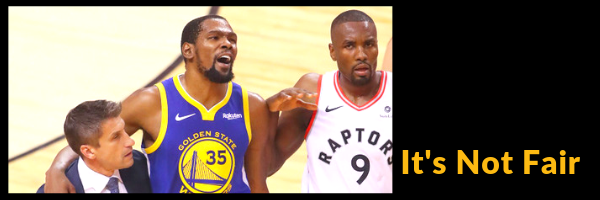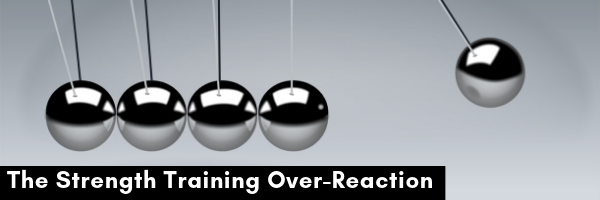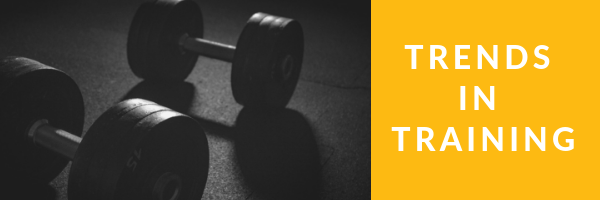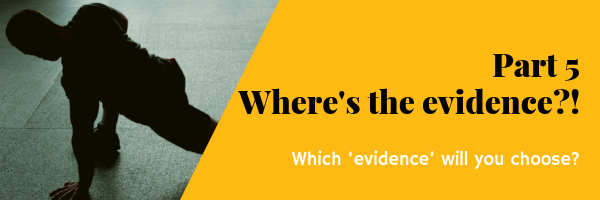The Barbell Hip Thrust – Winners and Losers
I was receiving requests from some of my coaches to write about the barbell hip thrust. They knew I didn’t buy into it, yet I had remained silent. They were tiring of the market pressure for them to conform, and wanted me to make a statement.
So I began to prepare, to research.
Didn’t take me long to realize I didn’t need to write an article about this exercise. There are already enough good ones out there. [1] [2] [3] [4]
What I have chosen to do instead is speak to the generation that ‘invented’, endorsed and more pertinently marketed this concept.
According to the number one advocate and ‘originator’ of the exercise, it all began in about 2006.
Almost 11 years ago, I thought up the barbell hip thrust in my garage gym in Scottsdale, Arizona. [5]
So in about 2008, this coach had a ‘bright idea’, apparently. Coach and writer Kim Goss has a different perspective on the history of this lift. [1]
Since then, I’ve been on a mission to popularize the movement…. took this information and ran with it, posting numerous article links and infographics on my social media channels relaying the news that hip thrusts are very well-suited for improving speed and that the force vector hypothesis was legitimate.[5]
Now the first ‘coach’ referred to above is a great marketer. I like to give credit where credit is due. The world adopted the movement. Not that they appear to need my acknowledgement. Enough acknowledgment was evident:
…I recently polled my newsletter list and social media followers and received over 7,600 responses as follow……As a prolific S&C educator with a large online following who gets rewarded for being “ahead of the research,” making bold predictions, and playing to the masses…
Rewards? Sounds like a game of winners and losers. And that may be accurate….
Then the bombshell. Some of his academic colleagues failed to support his own earlier studies.[7] [8] (And yes, the research undermining this exercise may have its own flaws, but no more than the original ‘research’ used to support it…)
Now the retraction did show humility and gained respect from some quarters.
Unfortunately, I spoke too soon. The combination of 1) my inherent biases as an inventor, 2) my role as an online educator always seeking to provide cutting edge information to my followers, and 3) my greenness as a scientist prevented me from exhibiting a more tempered approach to the emerging evidence.[9]
Here’s my challenge.
How many of the athletes and coaches currently engaging in this exercise are aware of this reversal of support and admission of ‘jumping the gun’? Not many.
Will the impact of this incredible marketing of this exercise go on for generations? Yes.
Who takes responsibility? No-one.
Who cares? Not enough people. Their too busy moving on to the next way of becoming significant or popular.
Now I understand no-one really wants unsolicited advice, however to those keen to be significant – I express my hope that a few more may first reflect upon the impact of what they market before they met their needs to be significant.
Now I am not suggesting that validation through science is needed before sharing an innovation. I personally don’t. Science is often a lagging indicator, confirming or otherwise at a later date. I would just recommend greater reflection or more transparency. If science is going to be invoked as a validation technique, you might want to have more than one of two ‘in-house studies’.
To the physical coach – please use the grey matter you were gifted by your Maker. I know this plea will fall for the most part on deaf ears, for the same ailment that Dr. Albert Schweitzer lamented in the 1950s remains. When he was asked by a reporter ‘Dr, what’s wrong with man today?’ he responded:
Man does not think. [10]
To the athlete – you need to be, and have a greater capability to me smarter about your training decisions than your physical coach. They have many masters – ego, colleagues to professional associations, marketing trends. You only have one agenda – the future health of your body and the fulfillment of your potential. Its okay to reach your own conclusions about what’s right for you, even if it differs from your coaches….
This rush to the market exemplifies one of the key reasons I have chosen historically to test a new concept for about a decade before publishing it….
A coach can ‘change their mind’ (even as they hope for a recovery) after marketing, publishing and endorsing something so effectively. [11] [12]
But the stain remains.
With influence comes responsibility.
[1] Goss, K., 2016, The case against hip thrusts, The Poliquin Group, June 14, 2016, http://main.poliquingroup.com/ArticlesMultimedia/Articles/Article/1478/The_Case_Against_the_Hip_Thrust.aspx
[2] Kavanaugh, J., The heavy hip thrust is ruining our backs and this industry, Speed and Sports Institute, https://www.sportandspeedteam.com/the-heavy-hip-thrust-is-ruining-our-backs-and-this-industry/
[3] Kechijian, D., 2017, Science’ and the Barbell Hip Thrust, Simplifaster, Sep 8, 2017, https://simplifaster.com/articles/barbell-hip-thrust/
[4] Valle, C., 2018, Should Advanced Athletes Use the Barbell Hip Thrust?, Simplifaster, Jan 29, 2018, https://simplifaster.com/articles/athletes-barbell-hip-thrust/
[5] Contreras, B., 2017, Science is self-correcting – The Case Of The Hip Thrust And Its Effects On Speed, Bretcontreras.com, July 27, 2017, https://bretcontreras.com/science-is-self-correcting-the-case-of-the-hip-thrust-and-its-effects-on-speed/
[6] Contreras, B., 2017, Science is self-correcting – The Case Of The Hip Thrust And Its Effects On Speed, Bretcontreras.com, July 27, 2017, https://bretcontreras.com/science-is-self-correcting-the-case-of-the-hip-thrust-and-its-effects-on-speed/
[7] Bishop, Chris, MSc; Cassone, Natasha, MSc; Jarvis, Paul, MSc; Turner, Anthony, PhD, CSCS*D; Chavda, Shyam, MSc, CSCS; Edwards, Mike, MSc, 2018, Heavy Barbell Hip Thrusts Do Not Effect Sprint Performance, An 8-Week Randomized–Controlled Study, The Journal of Strength and Conditioning Research · July 2017
[8] Kun-Han Lin, Chih-Min Wu, Yi-Ming Huang and Zong-Yan Cai, 2017, Effects of Hip Thrust Training on the Strength and Power Performance in Collegiate Baseball Players, Journal of Sports Science 5 (2017) 178-184
[9] Contreras, B., 2017, Science is self-correcting – The Case Of The Hip Thrust And Its Effects On Speed, Bretcontreras.com, July 27, 2017, https://bretcontreras.com/science-is-self-correcting-the-case-of-the-hip-thrust-and-its-effects-on-speed/
[10] Schweitzer, A., in Nightingale, E., 1975, The strangest secret, Nighingale-Conant.
[11] Contreras, B., 2017, Science is self-correcting – The Case Of The Hip Thrust And Its Effects On Speed, Bretcontreras.com, July 27, 2017, https://bretcontreras.com/science-is-self-correcting-the-case-of-the-hip-thrust-and-its-effects-on-speed/
[12] Cressey, E., 2017, In defense of the hip thrust, ericcressey.com, September 13, 2017, https://ericcressey.com/in-defense-of-the-hip-thrust

